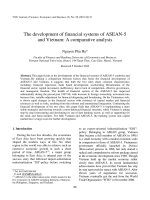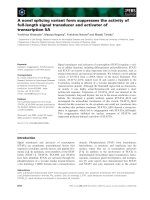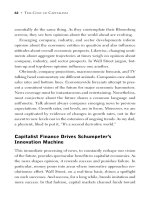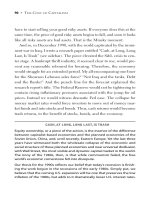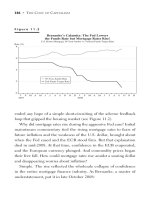The Financial Management Toolkit The Missing Financial Management Planning Process Theory and Tools Guide ITIL Compliant_2 pot
Bạn đang xem bản rút gọn của tài liệu. Xem và tải ngay bản đầy đủ của tài liệu tại đây (245.18 KB, 13 trang )
Financial Management Workbook
Page 13
This framework illustrates the commonality of interests and benefits between
the business and IT. Service and strategy design both benefit greatly from the
operational decision-making data that Financial Management aggregates,
refines and distributes as part of the Financial Management process.
Financial Management generates meaningful critical performance data used
to answer important questions for an organization, such as:
• Is our differentiation strategy resulting in higher profits or revenues,
lower costs, or greater service adoption?
• Which services cost us the most, and why?
• What are our volumes and types of consumed services, and what is
the correlating budget requirement?
• How efficient are our service provisioning models in relation to
alternatives?
• Does our strategic approach to service design result in services that
can be offered to a competitive market price, reduce risk or offer
superior value?
• Where are our greatest service inefficiencies?
• Which functional areas represent the highest priority opportunities for
us to focus on as we generate a CSI strategy?
Financial Management Workbook
Page 14
Reminder: Value for services is created by the combination of utility and
warranty.
The primary goal of Service Valuation is to produce a value for services that
the business perceives as fair, and fulfils the needs of the provider in terms of
supporting it as an ongoing concern. A secondary objective is the improved
management of demand and consumption behavior.
There is a Business Justification Document on page 67.
Financial Management Workbook
Page 15
Service Valuation concentrates on two key valuation concepts:
Provisioning value: the actual underlying cost to IT related to provisioning a
service. Input comes from financial systems, and consists of payment for
actual resources consumed by IT in the provisioning of a service. These cost
elements include items such as:
• Hardware and software license costs
• Annual maintenance fees for hardware and software
• Personnel resources used in the support or maintenance of a service
• Utilities, data centre or other facilities charges
• Taxes, capital or interest charges
• Compliance costs
The sum of these actual service costs typically represents the baseline from
which the minimum value of a service is calculated as providers are seldom
willing to offer a service where they are unable to recover the provisioning
cost.
Service Value Potential: is the value added component based on the
customer’s perception of value from the service or expected marginal utility
and warranty from using the service, in comparison with what is possible
using the customers own assets. Provisioning value elements add up first to
establish a baseline. The value-added components of the service are then
monetized individually according to their perceived value to estimate the true
value of the service.
Financial Management Workbook
Page 16
Financial demand modeling focuses on identifying the total cost of utilization
(TCU) to the customer, and predicting the financial implications of future
service demand.
Demand modeling uses service-oriented financial information with factors of
demand and supply in order to model anticipated usage by the business, and
provisioning requirements by IT. This is for identifying funding requirements,
variations and drivers of those variations, and to assist in the management of
service demand.
Financial Management Workbook
Page 17
Financial Management Workbook
Page 18
Financial Management Workbook
Page 19
Financial Management Workbook
Page 20
Operating and Capital processes are common and fairly standardized, and
involve the translation of IT expenditures into corporate financial systems as
part of the corporate planning cycle. Beyond this, the importance of this
process is in communicating expected changes in the funding of IT services
for consideration by other business domains. The impact of IT services on
capital planning is largely underestimated, but is of interest to tax and fixed
asset departments if the status of an IT asset changes.
Regulatory and Environmental – related planning should get triggers from
within the business. However FMIT should apply the proper financial inputs to
the related services value, whether cost based or value based.
Planning confidence is ultimately a combination of service-orientated demand
a modeling translated into measurable financial requirements with a high
degree of statistical accuracy. The financial requirements act as inputs in to
critical business decision making.
Financial Management Workbook
Page 21
The detail of the assumptions used in investment analysis can have a
significant impact on the outcome of the analysis.
In Service Investment Analysis, it is best to lean toward the use of an
exhaustive inventory of assumptions rather than a limited set of high-level
inputs, in order to generate a more realistic and accurate view of the
investment being made.
E.g. a service obtained via an instantly self deployable packaged software
solution residing on a single desktop and requiring little user support will have
a different investment profile than a service obtained through custom
development, global customer interaction and other resources that go into
creating, deploying and supporting an enterprise solution with multiple
language users.
Financial Management Workbook
Page 22
Financial Management plays an important role between corporate financial
systems and service management. The result of a service-oriented
accounting function is that far greater detail and understanding is achieved
regarding service provisioning and consumption, and the generation of data
that feeds directly into the planning process.
The functions and accounting characteristics that come into play are
discussed below:
• Service Recording
• Cost Types
• Cost Classifications – capital/operational, Direct/indirect,
Fixed/variable, Cost Units.
Further information can be found in following documents:
• Accounting Policies on page 73
• Budgeting Guidelines on page 77
• Charging Policies on page 83
Financial Management Workbook
Page 23
Information on Reports, KPIs and other Metrics can be found in a
separate document on page 89.
Financial Management Workbook
Page 24
Financial Management Workbook
Page 25
This covers detailed guidance in the form of sample models, methods,
activities and techniques for key areas.
Examples:
Service Valuation
• direct versus indirect costs
• labor costs
• variable cost element
• translation from cost account data to service value
Service provisioning models and analysis
• managed services
• shared services
• utility-based provisioning
• on-shore, off-shore or near-shore?
• service provisioning cost analysis
Funding model alternatives
• Rolling plan funding
• Trigger-based plans
• Zero-based funding
